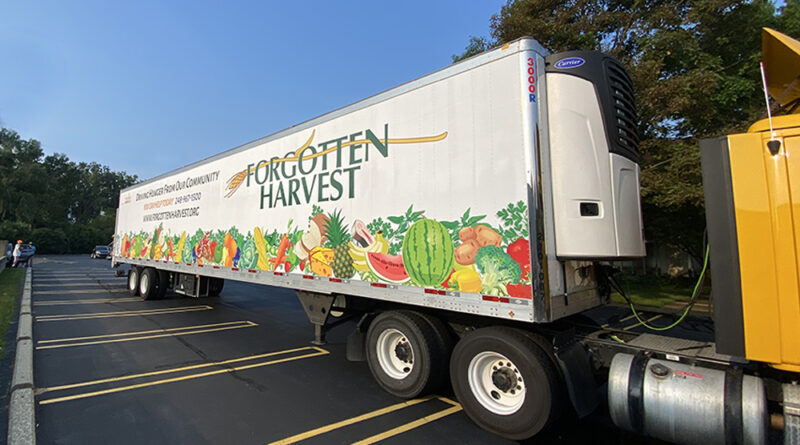Forgotten Harvest Works to Drive Out Hunger
I recently visited the Motor City and had the good fortune of witnessing an active Forgotten Harvest distribution location. Growing up in the Detroit area, I knew about this nonprofit whose motto is “Driving Hunger from Our Community,” but had never seen it in action.
This charitable entity opened its doors in 1990. As an ongoing food rescue organization, Forgotten Harvest schedules and collects donations of at least 200 pounds or more of surplus perishables and non-perishables from donors, such as restaurants, bakeries, caterers, and supermarkets.
At the scheduled time for pickup, Forgotten Harvest arrives with a refrigerated truck and forklift to retrieve the donations. This valuable service saves fresh and packaged food products that otherwise would go to waste and end up rotting in a landfill.
In 1994, Forgotten Harvest partnered with Kroger Co (NYSE: KR). And later in 2007, it won “Best-Managed Nonprofit in Detroit” by Crain’s Detroit Business.
While in partnership with Conagra Brands (NYSE: CAG), Forgotten Harvest earned the Gold Edison Award in 2012 for a “novel partnership between a food manufacturing plant and a food rescue resource to redirect perfectly good & edible, but historically discarded food from a landfill to feeding hungry people.”
GrantWatch has always been committed to the challenge of food insecurity and has many available grants focused on fighting this issue under both the farming/ agriculture and nutrition categories.
Despite all the good Forgotten Harvest is doing, I remember that caterers and businesses were hesitant to contribute, fearing possible litigation in the unlikely event that a recipient was injured from their contribution.
Donors need to be aware that the federal government has removed most liability risk from giving away surplus food. The exceptions reserved for intentional misconduct or violation of local health regulations.
In 1996, Former President Bill Clinton signed an action into law that was intended to encourage food donations.
The Bill Emerson Food Donation Act
“An Act, to encourage the donation of food and grocery products to nonprofit organizations for distribution to needy individuals by giving the Model Good Samaritan Food Donation Act the full force and effect of law.”
The act:
- Protects you from liability when you donate to a non-profit organization
- Protects you from civil and criminal liability should the product donated in good faith later cause harm to the recipient
- Standardizes (to all 50 states) donor liability exposure
- Sets a standard of ‘gross negligence’ or intentional misconduct for persons who donate grocery products
- Says that nothing shall be construed to supersede State or local health regulations
The Forgotten Harvest Facebook page lists the times and locations of food distribution sites. The volunteers I spoke to said they regularly interact with the locals, especially the kids who are home all summer, explaining that some parents are between jobs and worry about putting food on the table. This outdoor food distribution event not only brightens a kid’s face, but also helps keep the family healthy and fed.
Environmental Impact
The EPA (Environmental Protection Agency) has established a Food Recovery Hierarchy. It consists of six tiers listed in priority for the management of unused food, with six being the worst and last resort.
Food Recovery Hierarchy
- Source reduction — reduce the volume of surplus food generated.
- Feed hungry people — donate extra food to food banks, soup kitchens, and shelters.
- Feed animals — divert food scraps to animal food.
- Industrial uses — provide waste oils for rendering and fuel conversion and food scraps for digestion to recover energy.
- Composting — create nutrient rich soil amendment.
- Landfill-Incineration — last resort to disposal due to the fact that:
- Food in a landfill decomposes
- Decomposing produces methane
- Methane is a worse greenhouse gas than carbon dioxide.
- The food goes to waste, along with the resources that produced it.
- All the water, irrigation, farm labor and chemical fertilizers goes to waste.
- Wasted food should have gone to feed the people who gratefully appreciate and need it.
In addition to accepting and distributing food donations, the “Forgotten Harvest Farms,” is 103 acres of idyllic farmland near Detroit, in Fenton, Michigan. The Forgotten Harvest project grows and harvests over 850,000 pounds of fresh crisp produce.
Watch this short video on GrantWatch’s testimonial page of a similar nonprofit that recently won a $10,000 grant to provide 15,000 meals to food-insecure kids in its community.

